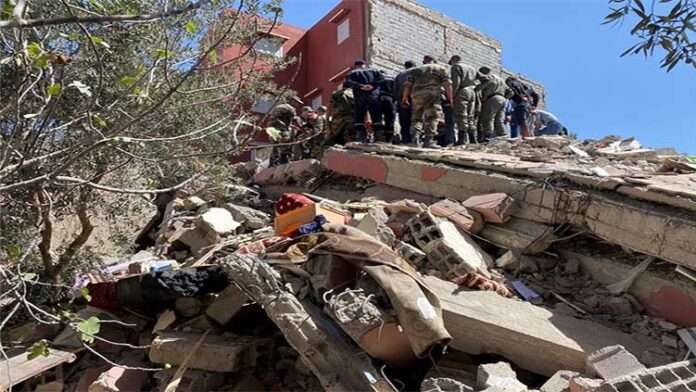The High Atlas Mountains in Morocco were the site of an open-air shelter for earthquake survivors on Saturday, a day after the country’s deadliest earthquake in more than six decades claimed more than 2,000 lives and destroyed entire villages.
The late-Friday earthquake cracked open houses made of mud brick, stone, and rough wood, and mosque minarets were knocked over. Neighbours were still looking for survivors buried on the slopes. Marrakech’s historic old city also sustained significant harm.
According to the Interior Ministry, there were 2,012 fatalities and 2,059 injuries, with 1,404 of those suffering from serious injuries. According to the US Geological Survey, the earthquake’s epicentre was about 72 kilometres (45 miles) southwest of Marrakech, and its magnitude was 6.8.
Rescuers in the village of Amizmiz, which is close to the epicentre, dug through the debris with their bare hands. Narrow streets were blocked by fallen masonry. Around ten bodies were covered in blankets outside a hospital, and nearby stood distraught family members.
“I hurried to get my kids out when I felt the house lean and the ground shake beneath my feet. My neighbours, however, were unable to, said Mohamed Azaw. ” Unfortunately, no one from that family was discovered alive. The mother and daughter are still missing, and the father and son were discovered dead.
Rescue workers in Amizmiz were perched atop one of the building’s pancaked floors as carpet and furniture fragments poked out of the wreckage. People gathered outside the only open store to wait in line for supplies. A road from Amizmiz to a nearby village was blocked by fallen boulders, underscoring the difficulties rescuers were facing.
The majority of the homes in the Asni neighbourhood, which is about 40 kilometres south of Marrakech, were destroyed, and the locals were getting ready to spend the night outside. The lack of food was caused by the collapse of kitchen roofs, according to villager Mohamed Ouhammo.
Asni resident Montasir Itri said rescue efforts were ongoing in search of survivors.
He stated, “Our neighbours are under the rubble, and people are frantically trying to rescue them using available means in the village.”
The worst-hit village Reuters saw was Tansghart in the Ansi region, on a valley’s incline where the road from Marrakech ascends into the High Atlas. The trembling ground shattered the once-beautiful houses that clung to the steep hillside. Wall or plaster pieces were missing from those that were still standing. Two minarets in mosques had collapsed.
A labourer named Abdellatif Ait Bella lay on the ground, unable to speak or move, his head bandaged from injuries brought on by falling debris.
His wife, Saida Bodchich, expressed concern for their family’s future, saying, “We have no house to take him to, and we haven’t had food since yesterday. Nobody else can be trusted but God.
According to a local, the village has already experienced ten fatalities, including two teenage girls.
Even Huelva and Jaen, in southern Spain, experienced tremors. According to the World Health Organisation, Marrakech and its environs are home to more than 300,000 affected individuals.
AIMING TO FIND SHELTER
In Marrakech, street camera footage captured the moment the earth started to tremble. Men suddenly looked around and jumped to their feet, while others ran for cover into an alleyway before escaping as dust and debris tumbled all around them.
In Jemaa al-Fna Square, the centre of the old city—a UNESCO World Heritage Site—a mosque’s minaret had collapsed. According to local Id Waaziz Hassan, a few homes in the densely populated old city collapsed, and residents had to clear the debris by hand while waiting for heavy machinery.
The Moroccan royal court announced on Saturday that the country will observe three days of national mourning, during which time the flag will be flown at half-staff nationwide.
According to the statement, the Moroccan military will send rescue teams to distribute tents, blankets, food supplies, and clean drinking water to the affected areas.
Turkey, the scene of devastating earthquakes that killed more than 50,000 people in February, was among the nations expressing solidarity and offering assistance.
Algeria, which severed ties with Morocco in 2021 as a result of rising hostilities between the two nations over the Western Sahara conflict, declared it would allow humanitarian and medical flights access to its airspace.
The earthquake was felt at a depth of 18.5 km, which is usually shallower, and earthquakes of the same magnitude are more destructive. According to the US Geological Survey, it was the deadliest earthquake to strike Morocco since a quake that is believed to have killed at least 12,000 people in 1960.
Scenes of the aftermath were compared to images from Turkey in February by Mohammad Kashani, associate professor of structural and earthquake engineering at the University of Southampton: “The area is full of old and historical buildings, which are primarily made of masonry. The reinforced concrete buildings that had collapsed that I had seen were either outdated or subpar.
Beginning on October 9, Marrakech will host the annual meetings of the World Bank and International Monetary Fund.
In response to a question regarding the upcoming meetings, an IMF spokesperson stated that “our sole focus at this time is on the people of Morocco and the authorities who are dealing with this tragedy.”






